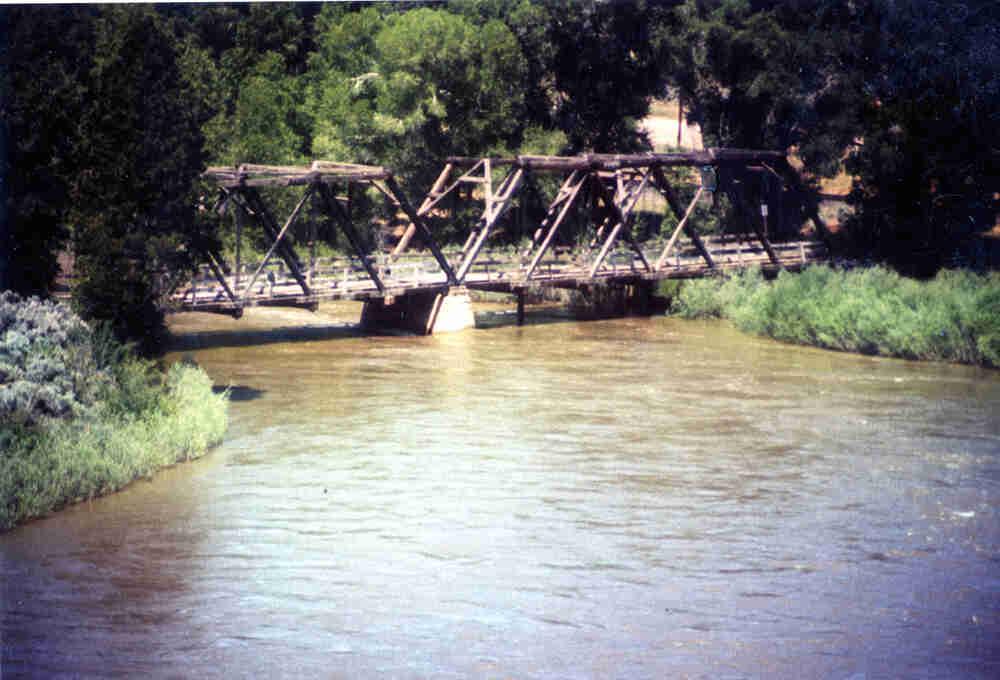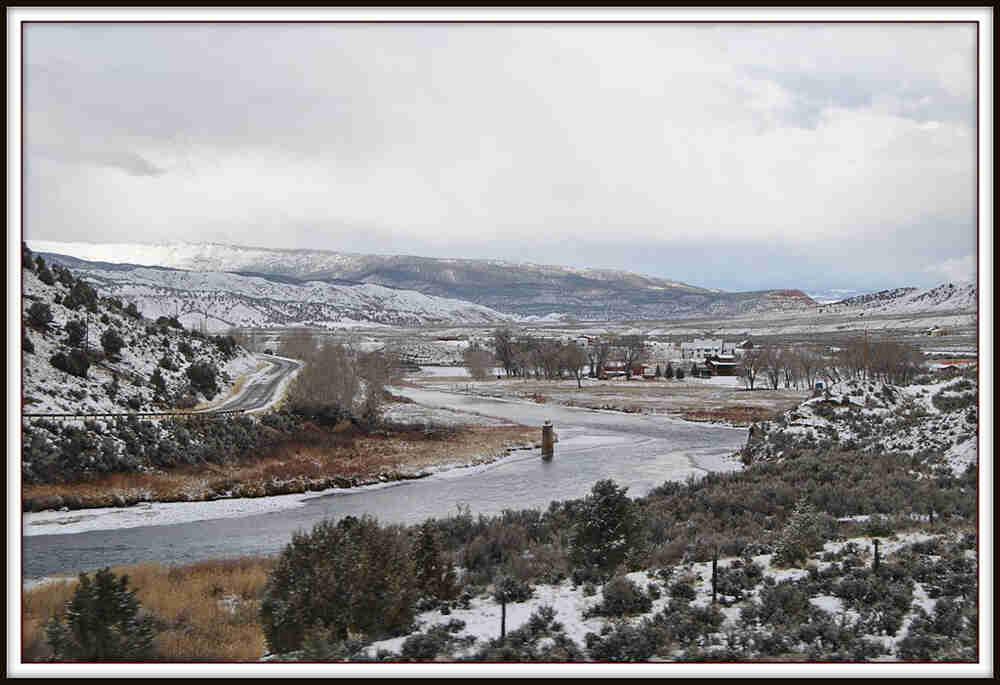State Bridge
Full Article
State Bridge spans the Colorado River along Highway 131 in Eagle County and was originally constructed in 1890. Built with state funding, the bridge helped promote growth by providing the only east–west transportation link across the state that was open year-round. The original truss bridge was replaced with a modern concrete deck bridge in 1966, but the construction of Interstate 70 through western Colorado caused State Bridge’s importance to decline after the 1970s.
Original State Bridge
In 1887 the Denver & Rio Grande Western Railroad built a line through the Eagle River valley, providing valley ranchers with much quicker and easier access to markets. North of the Eagle Valley, however, ranchers on the far side of the Grand River (now the Colorado River) still had to ferry or ford their livestock across the river to reach the railroad stockyards at Wolcott. The main river crossing between the Yampa Valley and Wolcott was operated by Charles H. McCoy, who plied a ferry about three miles west of his namesake town.
State officials believed a better route across the river would benefit ranchers and facilitate development in northwest Colorado, so in 1889 the state legislature appropriated $6,000 for a wagon bridge in Eagle County. The money came from the state’s Internal Income Fund, started in 1881 to pay for important county projects that would help knit together Colorado’s transportation network. Each project was designed and supervised by the State Engineer’s Office. The 1889–90 term marked the first time the legislature used the fund to engage in large-scale construction; in addition to the bridge in Eagle County, ten other projects were funded, mostly on the Western Slope.
Initially, state officials planned to build the Grand River bridge at McCoy’s ferry, which lay along the existing road through the area. The existing road was in bad shape, though, and officials soon decided that they would need a new road to accommodate the heavier loads that they anticipated after the bridge opened. They picked a new site about seven miles upriver from McCoy’s ferry, with new roads to the bridge to be built by Eagle and Routt Counties. The State Engineer’s Office designed the bridge and contracted with Missouri Valley Bridge and Iron Works of Leavenworth, Kansas, for its construction. Completed in October 1890, the bridge was made of native wood and wrought iron. It was 204 feet long and 16 feet wide, with a 100-foot Howe truss span—one of the most popular bridge designs at the time.
The bridge over the Grand River was the third of many “state bridges” to be constructed; by 1908 the state had funded more than eighty. Most took on different names, but this one—and the small community that developed beside it—continued to be known simply as State Bridge. It quickly assumed a key role in Colorado’s transportation infrastructure because it provided access to the railroad at Wolcott and was part of the only east–west route through the mountains that was open all year. Over the next seventy-five years, freight wagons, stagecoaches, automobiles, and ranchers used it frequently.
In the first decade of the twentieth century, the Denver, Northwestern & Pacific Railway started to build a new line to connect Denver and Salt Lake City. The line never reached that goal, but it did cross the Continental Divide via the Moffat Road and continue from there through Kremmling and State Bridge to Steamboat Springs and Craig. The wagon and stagecoach stop next to State Bridge soon evolved into a railroad stop as well, which opened the way to new business opportunities. By 1921 Ralph McGlochlin had bought an existing hotel at State Bridge with the plan of developing it into a modern tourist hotel and restaurant. In the 1930s and 1940s, McGlochlin’s lodge became a popular watering hole for nearby ranchers.
New State Bridge
Already in the 1940s, the Colorado Department of Highways (now the Department of Transportation) became concerned about the bad condition of Highway 131 from State Bridge to Wolcott. The bridge had partially collapsed during periods of high runoff in the late 1920s and in 1946 but in both cases was quickly fixed. The problem became more pressing as traffic increased along the road during the steady growth of outdoor recreation after World War II.
By the early 1960s, the Department of Highways had developed a long-term plan to improve the road and replace the seventy-year-old State Bridge. Pressure from Eagle County commissioners led Charles Shumate, the state’s chief highway engineer, to authorize the road and bridge project in September 1965. Construction on the Highway 131 improvements started in November 1965, and the new State Bridge was ready for traffic by late June 1966. A five-span girder bridge with a concrete deck slab, the new bridge stood just downstream from the original bridge. It measured 419 feet long across the river and 24 feet from curb to curb.
In the decade after the new State Bridge opened, its importance declined significantly as the construction of Interstate 70 provided a faster year-round route across the state. But while through-traffic decreased, State Bridge started to gain a reputation as an off-the-beaten-path destination for concerts, which started at a nearby lodge in the 1970s, and rafting on the Colorado River, which became popular in the 1980s.
During this time, the original bridge remained standing but was restricted to pedestrian traffic. It partially collapsed in the summer of 1983 during a period of high runoff. When the bridge was listed on the National Register of Historic Places in 1985, only the northern half of the wooden truss span was still in place. Today the rest of the span has collapsed, leaving only a concrete support in the river to mark the location of the original bridge.
In 2007 the historic lodge at State Bridge was destroyed by fire. The owners reopened in 2011 with a new amphitheater for concerts and renovated cabins and yurts for concertgoers, anglers, and rafters.















